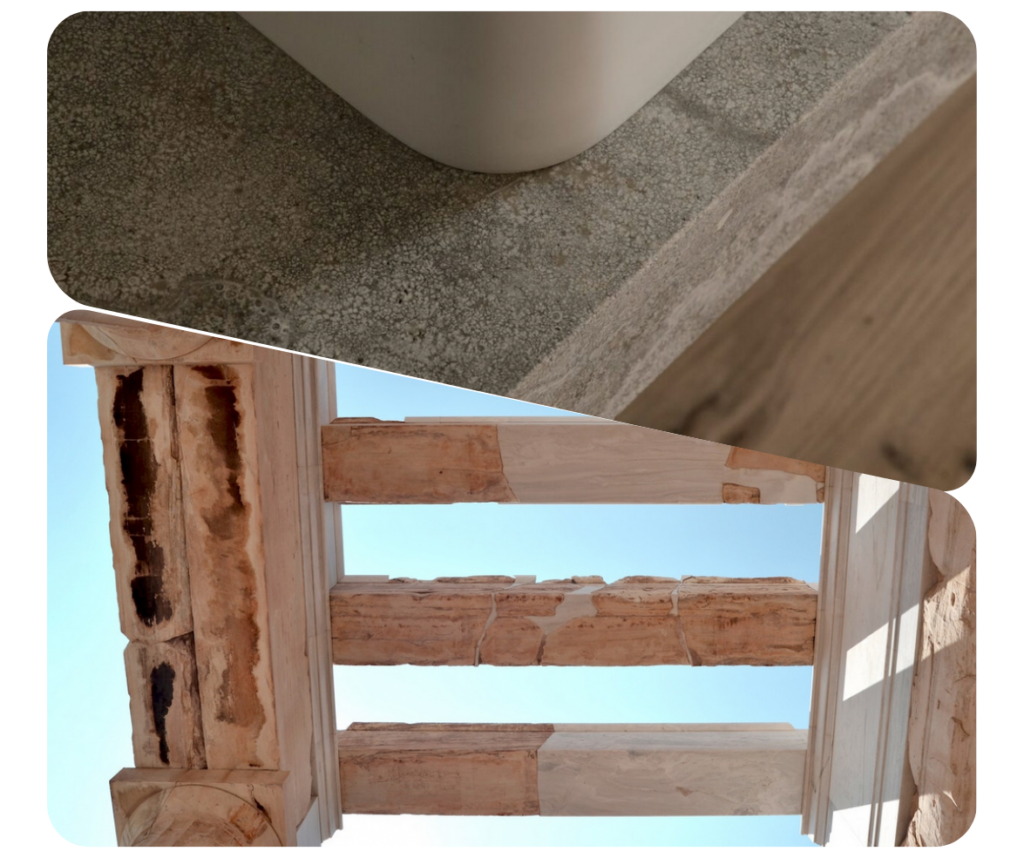Let’s be real – who doesn’t like marble? It adds a touch of luxury to any home and is durable, so it doesn’t wear down over time. Like a good Greek wine, it can even look better with age. Marble also comes from nature, so no two pieces are alike, and it brings a natural feel to your home that a man-made product can’t duplicate.
In Greece, marble has been used for over two thousand years in both its UNESCO monuments and in Greek homes. Because Greece has such great sources of marble, it continues to be used today. In this article, we explore the incredible types of marble in Greece from then and now.

Parian Marble
One of the best marbles for art historically in Greece is Parian marble. It is a pure white and flawless marble that was first used in the classical era on the island of Paros. The ancient Greeks used it for sculptures like Venus de Milo, Hermes and the Infant Dionysus, for the Parthenon’s roof, and later for Napoleon’s tomb. It can also be found in Delos, Delphi, Athens, and Olympia in public buildings.
One of the biggest mines in Paros was called the “Quarry of the Nymphs” which produced 100,000 cubic meters of marble in the past. Slaves used to work there under lamplight.

Pentelic Marble
Pentelic marble is also a flawless white stone that looks slightly golden under the sun. It is found at Mount Penteli, which is not far from Athens. If you look at the mountain today from Athens, you can see “wounds” from all the quarries there. Pentelic marble was used as long ago as 570 BC, and it was used in the Older Parthenon in 450 BC. It became the primary material for the Acropolis’s buildings and in the statues of the surrounding area.
When the Romans ruled Greece, Julius Caesar also used it in the new Roman Agora. In the 2nd century, pentelic marble was used in the Temple of Olympian Zeus as well as the Panathenaic Stadium (Kallimarmaro) which was such a large project that it used up almost all of the available supply.
Other Types of Marble
By the time the Romans were using Greek marble, they weren’t happy with only white marble. They wanted multicolored marble, which was available in some areas of Greece. For example, they imported green and red marble from the Peloponnese, grey marble from Evia, and black marble from Chios. Green marble could also be found in Skyros and Tinos, and Thasos has a nice white marble that is close in quality to Pentelic.
Below is an example from K-studio in a home in Mykonos, where floors, bathrooms, and bedroom tables were constructed with Greek marble.

Thebes Marble
Some of the most beautiful dark yellow marble is found near Thebes, in the Elikonas mountain. Here, back in the middle ages, the area was known for its stone mansions, some which are still standing today. The marble from Thebes has been used in many contemporary pieces of art and even for the decorating of the John F. Kennedy memorial.
Now and Then
Mining marble is different than it was in ancient times. In ancient times, mostly only hand tools were used, and the work had very little error. The craftsmen and sculptors said that their work was a gift to the gods, and the masters knew how to pick the best marble. They usually got the marble from mountain sites and then brought it to the worksite with different ropes, cranes, carts, and rollers.

Marble in Tinos
The island of Tinos in the Cyclades has always been known for its marble works. Back in the 1950s, craftsmen from Tinos were hired to reconstruct the Stoa of Attalos. Later in the 1970s, they were called on to work on the Erechtheion in Athens. Today, traditional workers from Tinos are doing restorations on the Parthenon.
A local legend says that Tinos’s locals were taught by Phidias himself, a famous sculptor from the 5th century BC. We don’t know if this is true, but Tinos’s sculptors definitely were a part of the making of the Academy of Athens, the Athens Concert Hall and the National Library.

The Town of Pyrgos
One town is Tinos is especially for its marble: Pyrgos. It is the largest village on the island and has 1000 residents. Some people call it “an open-air marble museum.” Marble is found all over the town, both in public buildings and in homes, door lintels, and fountains. A number of local craftsmen sell marble artwork in their showrooms.

Marble Today in Greece
Greece still has many areas with high quality marble. It is a big part of the economy. Julie Haidas, CEO of marble suppliers Iktinos, says that “Marble is in the top 10 exports of Greek products, and that’s because our focus is to export it.” She says that for every euro the marble industry produces, it contributes about 2.20 euros to the economy, more than double. “We like to say that marble is one of the best products we export to the world.” In fact, Greece exports over 75% of the marble it harvests.
Below is an example from K-studio in a home in the Peloponnese, where floors, bathrooms, and counters were constructed with Greek marble.









